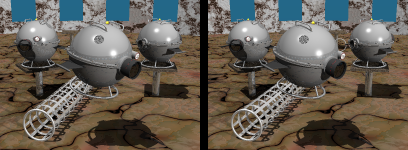Parallel/cross-eyed 3d view
This describes the parallel and cross-eyed 3d view.
The parallel view method
![pview.png [4kb]](pview.png) |
The parallel view method is easily explained. The left and right images are put horizontally next to each other at a distance of not more than 65mm (which is the average human eye distance). The viewer needs to hold his head exactly vertical and try to look "through" the projection plane as if he was looking at an infinite distant object. Normally, when doing this for the first time it is hard because the eyes need to focus on some fairly near image while there is no or only little convergence (angle between the left and right eye directions). However, after looking at it for a while, one gets used to it and the images get sharp with fairly well 3d effect. While it is quite easy to achieve orthostereographic projection using this way, there is little use for the parallel view method since it limits the (horizontal) image size to about 65mm and is best presented on printed paper. |
The cross-eyed view method
![xview.png [5kb]](xview.png) |
The cross-eyed view method works much like the parallel view method
with the left and right images exchanged.
Hence, when looking at the images, the viewer must look at the left image
with the right eye and vice versa which means that the convergence angle
is fairly large. This, in turn, allows to use somewhat larger images
(more than 65mm wide). As with the parallel view method, when looking at it for the first time, it is hard to get the images sharp because the brain thinks the focus point is much nearer due to the large convergence angle. After some time (contemplate!) one can overcome that.
Note that there is no way to achieve orthostereographic projection using
the cross-eyed view method since the eye rays for infinite distant objects
cross about half way in front of the projection plane. (In order to correct
for that one would have to transform it into a parallel view image.) |
Sample images
I'll put some nicer images here in the future. Meanwhile, this one has to be looked at using the parallel view method. Use the version whose images are no wider than 65mm (2.5inch).


Hint: If you really want to look at these cross-eyed, simply turn the screen top-to-bottom around or do a headstand while looking at them :)
| [home] [site map] [Impressum] [Datenschutz/privacy policy] |
|
|